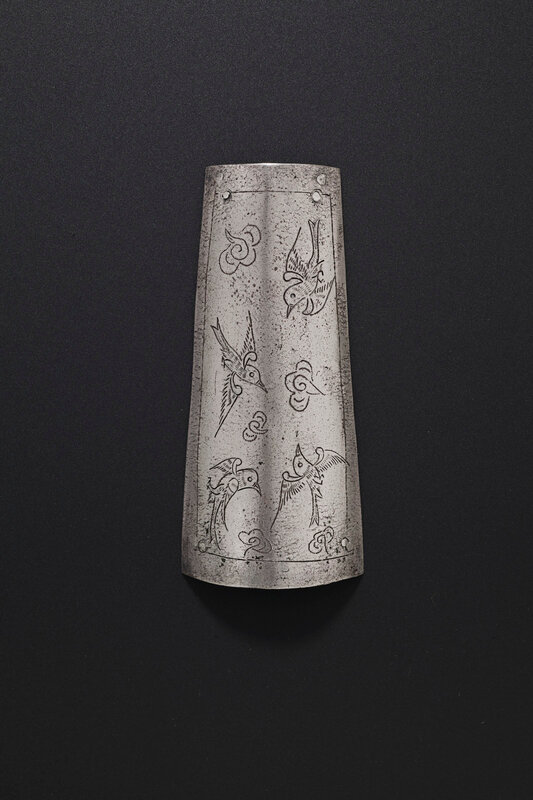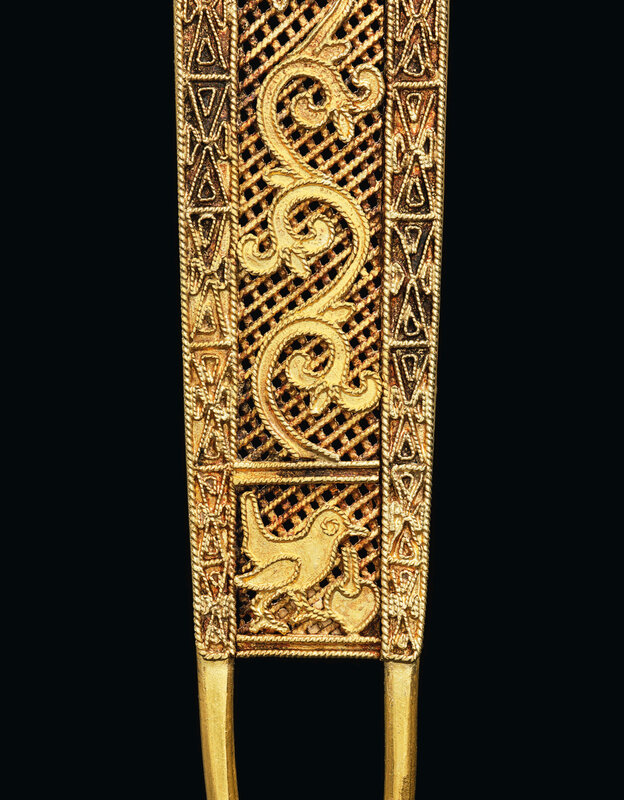10th century & Liao Dynasty Masterpieces of Early Chinese Gold and Silver from Dr. Johan Carl Kempe at Christie's NY
Lot 576. A rare gold 'kalavinka' hairpin ornament, Liao dynasty (AD 907-1125); 2 in. (5.1 cm) wide; weight 6.1 g. Estimate USD 8,000 - USD 12,000. © Christie's Image Ltd 2019.
The front of the ornament is shaped in repoussé as a bejeweled kalavinka, its hands crossed in front of the chest as it floats amidst clouds. All of the outlines are beaded and it is soldered to a plain gold back.
Provenance: Dr. Johan Carl Kempe (1884-1967) Collection, Sweden, before 1953, no. CK35.
Sotheby's London, Masterpieces of Chinese Precious Metalwork. Early Gold and Silver, 14 May 2008, lot 87.
Literature: Bo Gyllensvärd, Chinese Gold and Silver in the Carl Kempe Collection, Stockholm, 1953, cat. no. 35.
Bo Gyllensvärd, 'T'ang Gold and Silver', Bulletin of the Museum of Far Eastern Antiquities, No. 29, Stockholm, 1957, fig. 82b.
Chinese Gold and Silver in the Carl Kempe Collection, The Museum of Art and Far Eastern Antiquities in Ulricehamn, Ulricehamn, 1999, pl. 33.
Exhibited: Washington, D.C., Smithsonian Institution, Chinese Gold and Silver in the Carl Kempe Collection, 1954-55, cat. no. 35.
Note: This rare gold ornament is in the form of a kalavinka, a winged celestial being that is half woman- half bird. This unusual being can be seen as the central decoration of several gold and silver bowls dated to the Liao dynasty and illustrated in Chinesisches Gold und Silber: Die Sammlung Pierre Uldry, Zürich, 1994, pp. 215-16, pls. 244-247. Like the present figure, the kalavinkas on the bowls have feathered wings and bodies and the hair is worn in a topknot. Based on its size and construction, it is likely that the present gold ornament is the head or terminal of a gold hairpin. Such a terminal, in the shape of Xiwangmu seated on a phoenix, can be seen on a gold hairpin dated to the Song dynasty illustrated by Julia M. White and Emma C. Bunker, Adornment for Eternity: Status and Rank in Chinese Ornament, Denver Art Museum, 1994, p. 181, pl. 93.
A very similar gold ornament in the collection of the Minneapolis Institute of Art, Minneapolis, was included in the exhibition, The Art of the T'ang Dynasty, Los Angeles County Museum, 1957, no. 303, and was also included in the exhibition, Early Chinese Gold and Silver, China House Gallery, China Institute in America, New York 1971, no. 31. In Chinese Gold and Silver in the Carl Kempe Collection, Stockholm, 1953, p. 89, no. 35, Bo Gyllensvärd notes that a similar pair, in the full round, is in the collection of The Freer Gallery of Art, Washington, D.C.
Lot 587. A small silver reliquary, 10th century; 4 1/8 in. (10.5 cm.) long; weight 132 g. Estimate USD 4,000 - USD 6,000. © Christie's Image Ltd 2019.
The reliquary is shaped as a miniature coffin engraved on each side with a striding dragon and a flower on each end. The cover is decorated with four birds in flight amidst scattered scrolling clouds.
Provenance: Dr. Johan Carl Kempe (1884-1967) Collection, Sweden, before 1953.
Sotheby's London, Masterpieces of Chinese Precious Metalwork. Early Gold and Silver, 14 May 2008, lot 101.
Literature: Bo Gyllensvärd, Chinese Gold and Silver in the Carl Kempe Collection, Stockholm, 1953, cat. no. 144.
Han Wei, Hai nei wai Tangdai jin yin qi cuibian [Tang Gold and Silver in Chinese and overseas collections], Xi'an, 1989, pl. 327.
Exhibited: Washington, D.C., Smithsonian Institution, Chinese Gold and Silver in the Carl Kempe Collection, 1954-55, cat. no. 144.
Note: Reliquaries of this type, made in the shape of a coffin or stone sarcophagus, were produced in various precious materials including gold, silver, crystal and jade during the Tang dynasty. The coffin-shaped reliquaries were made to hold sacred relics and were made in various sizes so that they could be fitted one within the other. Examples of this are the two small coffin-shaped caskets found in the Famen Temple, Shaanxi province in 1987. The larger of the two, 10.5 cm. long, is made of crystal, and the smaller, 6.5 cm. long, which fits inside, is made of jade. It was this latter reliquary that was said to hold Buddha's finger bone. These two reliquaries were contained within three other caskets of square shape: iron, gilt-silver and sandalwood, all of diminishing size, with the outer iron casket 22 x 22 cm. in size. All of the aforementioned, except for the sandalwood casket, are illustrated by Carol Michaelson in Gilded Dragons: Buried Treasures from China's Golden Ages, The British Museum, 1999, pp. 160-62, nos. 117-120. Two small parcel-gilt silver coffin-shaped reliquaries also found in the Famen Temple are illustrated by Zhang Tinghao, ed., Famen Temple, Shaanxi, 1990, pp. 83 and 87.
The tradition of coffin-shaped reliquaries continued into the Song dynasty. A silver example, 11.5 cm. at its highest end, was recovered from the 'underground palace' of the Song-dynasty Jingzhi Temple pagoda at Dingzhou, Hebei province, which was built in AD 977. See the catalogue for the exhibition, Treasures from the Underground Palaces: Excavated Treasures from Northern Song Pagodas, Dingzhou, Hebei Province, China, Idemitsu Museum of Arts, Tokyo, 1997, col. pl. 3, and no. 3, p. 123. As with the present reliquary, the sides are engraved, with the Green Dragon on one side and the White Tiger on the other.
Lot 574. Two silver hairpins, 10th century; 6 3/8 and 5 ½ in. (16.3 and 14 cm.) long; weight 7.3 and 4.6 g. Estimate USD 4,000 - USD 6,000. © Christie's Image Ltd 2019.
Each with an openwork head: one chased with two birds flanking a ribbon with trailing ends, the details engraved and highlighted in gilding; the second similarly decorated inrepoussé with a pair of geese in flight.
Provenance: Dr. Johan Carl Kempe (1884-1967) Collection, Sweden, before 1953, no. CK149 and CK150.
Sotheby's London, Masterpieces of Chinese Precious Metalwork. Early Gold and Silver, 14 May 2008, lot 100.
Literature: Bo Gyllensvärd, Chinese Gold and Silver in the Carl Kempe Collection, Stockholm, 1953, cat. nos. 149 and 150.
The 'geese' hairpin: Bo Gyllensvärd, 'T'ang Gold and Silver', Bulletin of the Museum of Far Eastern Antiquities, No. 29, Stockholm, 1957, fig. 89d.
Chinese Gold and Silver in the Carl Kempe Collection, The Museum of Art and Far Eastern Antiquities in Ulricehamn, Ulricehamn, 1999, pls. 47 and 148.
Exhibited: Washington, D.C., Smithsonian Institution, Chinese Gold and Silver in the Carl Kempe Collection, 1954-55, cat. nos. 149 and 150.
Lot 563. A pair of gold filigree hairpins, 10th-13th century or later. Each 7 ½ in. (19 cm.) long; weight 35.8 and 34.3 g. Estimate USD 30,000 - USD 50,000. © Christie's Image Ltd 2019.
The ornate head of each double-pronged hairpin is comprised of a very fine sheet of delicate latticework decorated with a small bird with a leafy spray in its beak below a scrolling meander, all outlined in fine twisted wire and enclosed within a geometric border.
Provenance: Dr. Johan Carl Kempe (1884-1967) Collection, Sweden, before 1953, no. CK45.
Sotheby's London, Masterpieces of Chinese Precious Metalwork. Early Gold and Silver, 14 May 2008, lot 91.
Literature: Bo Gyllensvärd, Chinese Gold and Silver in the Carl Kempe Collection, Stockholm, 1953, cat. no. 45.
Bo Gyllensvärd, ‘T’ang Gold and Silver’, Bulletin of the Museum of Far Eastern Antiquities, No. 29, Stockholm, 1957, figs. 13h, 53a, 77b.
Chinese Gold and Silver in the Carl Kempe Collection, The Museum of Art and Far Eastern Antiquities in Ulricehamn, Ulricehamn, 1999, pl. 44.
Exhibited: Washington, D.C., Smithsonian Institution, Chinese Gold and Silver in the Carl Kempe Collection, 1954-55, cat. no. 45.
New York, Asia House Gallery, Chinese Gold, Silver and Porcelain. The Kempe Collection, 1971, cat. no. 20, an exhibition touring the United States and shown also at nine other museums.
Note: A related gold hairpin, also decorated with an area of filigree openwork in the head of the hairpin, is illustrated in Celestial Creations: Art of the Chinese Goldsmith, The Cheng Xun Tang Collection, vol. I, Art Museum, Institute of Chinese Studies, The Chinese University of Hong Kong, 2007, no. C04. See, also, the example illustrated by Simon Kwan and Sun Ji, Chinese Gold Ornaments, Hong Kong, 2003, pp. 346-47, pl. 197. Both of these hairpins are dated to the Tang dynasty.
Christie's. Masterpieces of Early Chinese Gold and Silver, New York, 12 September 2019

/https%3A%2F%2Fprofilepics.canalblog.com%2Fprofilepics%2F1%2F0%2F100183.jpg)
/https%3A%2F%2Fstorage.canalblog.com%2F03%2F02%2F119589%2F96711876_o.jpg)
/https%3A%2F%2Fstorage.canalblog.com%2F11%2F31%2F119589%2F94773502_o.jpg)
/https%3A%2F%2Fstorage.canalblog.com%2F20%2F83%2F119589%2F94772815_o.jpg)
/https%3A%2F%2Fstorage.canalblog.com%2F26%2F72%2F119589%2F75604929_o.jpg)
/https%3A%2F%2Fstorage.canalblog.com%2F59%2F60%2F119589%2F26458628_o.jpg)










/image%2F1371349%2F20240408%2Fob_bbb9e7_2024-nyr-22642-0884-000-a-silver-hexal.jpg)
/image%2F1371349%2F20240407%2Fob_4b2318_2024-nyr-22642-0882-000-a-pair-of-silv.jpg)
/image%2F1371349%2F20240229%2Fob_c650f1_425344618-1624788374957842-51266877057.jpg)
/http%3A%2F%2Fstorage.canalblog.com%2F70%2F03%2F119589%2F129837682_o.jpg)